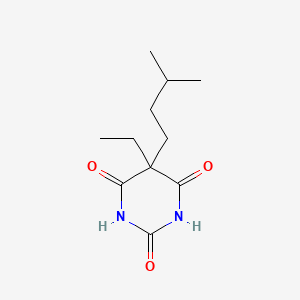Compound
D0510 | amytal
N
N05CA02 Amobarbital
[N05CA] Barbiturates, plain
[N05C] HYPNOTICS AND SEDATIVES
[N05] PSYCHOLEPTICS
[N] Nervous system
| Toxicity | Dose | Time | Species | Model | Method | Action | Positive criterion | Reference |
|---|---|---|---|---|---|---|---|---|
| ELECTRON TRANSPORT CHAIN | affect | 53 | ||||||
| ELECTRON TRANSPORT CHAIN | 0.2 mM | NADH–Q-1 | decrease | IC50 | 112 | |||
| Target | Dose | Time | Species | Model | Method | Action | Positive criterion | Reference |
|---|---|---|---|---|---|---|---|---|
| NADH:ubiquinone reductase | 0.2 mM | NADH–Q-1 | inhibitor | IC50 | 112 | |||
| NADH:ubiquinone reductase | 185 | |||||||
| semiquinone | antagonist | 53 | ||||||
| Pictogram | Signal | Statements | Precautionary Statement Codes |
|---|---|---|---|
 |
Danger |
Aggregated GHS information provided by 40 companies from 1 notifications to the ECHA C&L Inventory. H301 (100%): Toxic if swallowed [Danger Acute toxicity, oral] Information may vary between notifications depending on impurities, additives, and other factors. The percentage value in parenthesis indicates the notified classification ratio from companies that provide hazard codes. Only hazard codes with percentage values above 10% are shown. |
P264, P270, P301+P310, P321, P330, P405, and P501; (The corresponding statement to each P-code can be found at the GHS Classification page.) |
| 057A558 | 2,4,6(1H,3H,5H)-Pyrimidinetrione, 5-ethyl-5-(3-methylbutyl)- | 2,6(1H,3H,5H)-Pyrimidinetrione, 5-ethyl-5-(3-methylbutyl)- |
| 5-Ethyl-5-(3-methylbutyl)-2,4,6(1H,3H,5H)-pyrimidinetrione | 5-Ethyl-5-(3-methylbutyl)-2,6(1H,3H,5H)-pyrimidinetrione | 5-Ethyl-5-(3-methylbutyl)barbituric acid |
| 5-Ethyl-5-isoamylbarbituric acid | 5-Ethyl-5-isoamylmalonyl urea | 5-Ethyl-5-isopentyl-2,4,6(1H,3H,5H)-pyrimidinetrione # |
| 5-Ethyl-5-isopentylbarbituric acid | 5-Ethyl-5-isopentylbarbitursaeure | 5-Isoamyl-5-ethylbarbituric acid |
| 5-ethyl-5-(3-methylbutyl)-1,3-diazinane-2,4,6-trione | 5-ethyl-5-(3-methylbutyl)pyrimidine-2,4,6(1H,3H,5H)-trione | 57-43-2 |
| AMAL | API0001485 | Amasust |
| Amital | Amobarbital (JP17/INN) | Amobarbital 0.1 mg/ml in Methanol |
| Amobarbital 1.0 mg/ml in Methanol | Amobarbital [INN:JAN] | Amobarbital [USP:INN:BAN:JAN] |
| Amobarbital solution, 1.0 mg/mL in methanol, ampule of 1 mL, certified reference material | Amobarbital suppository dosage form | Amobarbitale |
| Amobarbitale [DCIT] | Amobarbitalum | Amobarbitalum [INN-Latin] |
| Amobarbitone | Amospan | Amybal |
| Amylbarbitone | Amylobarbital | Amylobarbitone |
| Amylobarbitone|||Amytal|||5-Ethyl-5-isoamylbarbituric acid | Amytal | BIDD:PXR0091 |
| Barbamil | Barbamyl | Barbamyl acid |
| Barbituric acid, 5-ethyl-5-isoamyl- | Barbituric acid, 5-ethyl-5-isopentyl- | Binoctal |
| C07536 | CAS-57-43-2 | CBDivE_006514 |
| CCRIS 5454 | CHEBI:2673 | CHEMBL267894 |
| D00555 | DB01351 | DEA No. 2125 |
| DSSTox_CID_81 | DSSTox_GSID_20081 | DSSTox_RID_75353 |
| DTXSID9020081 | Dexamyl (Salt/Mix) | DivK1c_000994 |
| Dorlotyn | Dormytal | EINECS 200-330-7 |
| Ethylisopentylbarbituric acid | Eunoctal | FT-0662116 |
| GWH6IJ239E | HSDB 3286 | IDI1_000994 |
| InChI=1/C11H18N2O3/c1-4-11(6-5-7(2)3)8(14)12-10(16)13-9(11)15/h7H,4-6H2,1-3H3,(H2,12,13,14,15,16); | Isoamylethylbarbituric acid | Isomyl |
| Isomytal | Isomytal (TN) | KBio1_000994 |
| LS-7196 | Mylodorm | NCGC00247711-01 |
| NINDS_000994 | NSC 10815 | NSC-10815 |
| NSC-120800 | NSC-32406 | NSC10815 |
| NSC120800 | NSC32406 | Oprea1_587446 |
| Pentymal | Pentymalum | Q415850 |
| Robarb | SCHEMBL15364946 | SCHEMBL43780 |
| Schiwanox | Sednotic | Somnal |
| Stadadorm | Sumital | Talamo |
| Tox21_112866 | UNII-GWH6IJ239E | VIROVYVQCGLCII-UHFFFAOYSA- |
| VIROVYVQCGLCII-UHFFFAOYSA-N | WLN: T6VMVMV FHJ F2 F2Y1&1 | ZINC4811698 |
| amobarbital | component of 15-90 | component of 15-90 (Salt/Mix) |
| component of Amo-Dextrosule | component of Amo-Dextrosule (Salt/Mix) | component of Dexamyl |
| component of Dexamyl (Salt/Mix) | component of Q-Caps | component of Q-Caps (Salt/Mix) |

